The project of the engineering machine Breton-Prétot Apparatus (France)
The initiator of the creation of a specialized engineering machine became Jules-Louis Breton, a scientist and politician. Taking up his post in the structures of power, J.-L. Breton saw the problems of the army and expressed a desire to help the soldiers in the fight against the enemy. In November, 1914, he proposed an original idea of creating a self-propelled, protected machine with a set of special equipment designed for cutting wire fences. In the near future, Prétot was involved in the development of the project. This organization had a certain experience in creating and assembling various self-propelled vehicles, which was planned to be used in a new project. The names of the inventor and the head of the production company soon became the name of the project - Breton-Prétot.
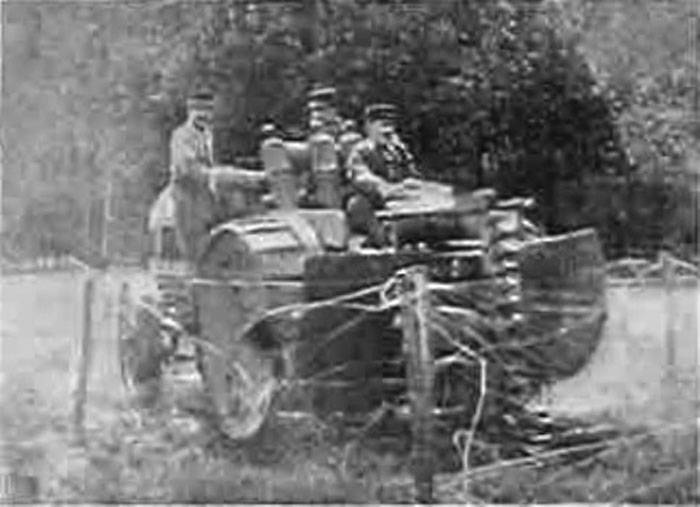
The Breton-Prétot Apparatus engineering vehicle is on trial
The first version of the engineering machine Breton-Prétot Apparatus had a fairly simple design and in fact was supposed to be a technology demonstrator. It was proposed to mount a set of special equipment on a four-wheeled trolley with its own power plant. As part of the latter should have been a separate engine power 6 hp, associated with a vertically located circular saw. The latter was placed in front of the base platform on a beam of sufficient length and connected to the engine using a chain transmission. Such a machine could in theory approach enemy obstacles and cut them, making passages for the soldiers of their army.
In November 1914, Breton and Preto proposed the first version of their project to the military department. In general, the military were satisfied, resulting in the continuation of work. In January of the following year, Prétot built a prototype engineering vehicle, distinguished by its simplified design. Such a machine was released for testing, where it showed its potential. The prototype confirmed the possibility of cutting barriers, but the practical value of such a machine was not too great. She did not have any protection and was also characterized by unacceptably low mobility.
According to the results of tests of the first prototype, a decision was made to revise the project significantly. The existing wheeled platform had insufficient characteristics, which is why it was planned to transfer the mechanisms for cutting to a new chassis. The characteristic features of the battlefields of the First World War required the use of a tracked chassis with appropriate capabilities. Nevertheless, the authors of the project did not manage to find a free car with suitable characteristics. Because of this, a commercial tractor of one of the existing models was involved in the new version of the project.
At the end of January 1915, the Preto enterprise again brought to the test a prototype of a promising engineering machine. The second prototype was different from the first with a number of features associated with both the use of the new chassis and the upgrading of the target equipment. Externally, the prototype resembled a conventional agricultural tractor with equipment mounted on it. Interestingly, in the future it was planned to equip the car with armor, however, during the tests, weight simulators were used instead. As a result, the outwardly experienced tractor with the equipment for cutting the wire almost did not differ from the base machine.
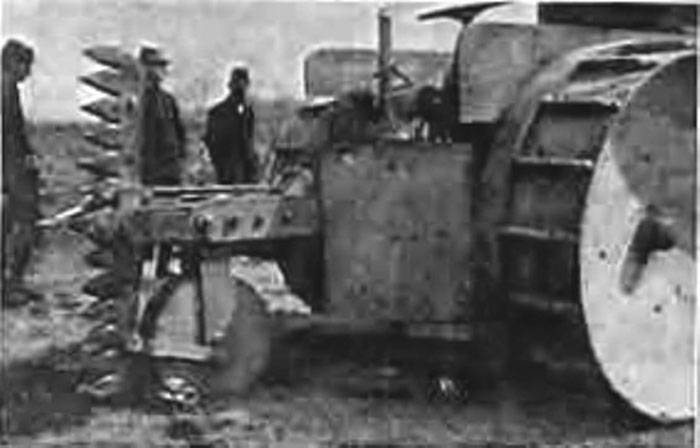
Machine tool
A Bajac tractor was chosen as the basis for the second Breton-Prétot Apparatus prototype. This car was built according to the classic layout for such a technique. The front part of the frame was given under the engine, and in the back was the driver's workplace. There was a four-wheeled chassis with a leading rear axle, equipped with oversized wheels. To improve mobility on rough terrain, the rear wheels were made of metal and had a rigid structure. The tractor was equipped with a gasoline engine. Own weight of the car reached 3 t. After installing the armored corps, the combat mass could grow by about a ton.
According to the remaining data, it was planned to mount a sufficiently simple hull on the tractor chassis, able to protect the crew and machine from weapons or fragments of artillery shells. The engine compartment of the tractor should be covered with a U-shaped cover. The cab could have a rectangular hull with a sloping top. At the last installation of a machine-gun for self-defense was envisaged. Around the perimeter of the armored cabin-cockpit should have several viewing hatches and slots.
At the stern of the chassis they hung up a block of special equipment responsible for cutting the wire. On the frame mounting devices, a large case was placed, inside which certain units were placed. A horizontal beam departed from the hull, which served as a support for the working body. The hull and beam were equipped with its own transmission for transferring the engine power to the cutting device. Due to the relatively large weight of the special equipment received its own supporting wheel.
The working body of the Breton-Prétot machine of the second type was a vertical device with 13 protruding teeth pointing backwards relative to the tractor. On the beam-base teeth also placed a chain saw. It was assumed that the teeth would pull the barbed wire into the desired position and hold it, after which the chain saw would perform cutting.
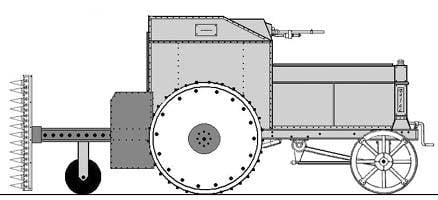
Wire cutter on armored tractor
Also, the authors of the project provided for the equipment of the engineering machine with a large circular saw placed in a horizontal position. Such a saw was supposed to be at a small height above the ground. It was assumed that with its help the engineering machine would be able to cut off the pillars holding the wire fence. The saw was under the rear of the chassis, between the wheels.
According to some reports, in February or March 1915 of the year J.-L. Breton and the company Prétot conducted tests of the prototype, which resulted in the decision to change the project. Construction processing continued for several months. In July, an updated experimental machine was released for testing. During the rework, she lost a horizontal circular saw, and also received a ballast that mimics the weight of an armored hull. Eight obsolete artillery pieces made of bronze were used as ballast.
22 July updated engineering machine has passed new tests, during which fully confirmed all expectations. The cutting device of the original design effectively destroyed the typical wire barriers, forming a passage of sufficient width. Despite some difficulty in driving the car backwards, the whole Breton-Prétot Apparatus performed well. The military was satisfied, resulting in an order for the continuation of work and the construction of serial equipment.
According to the results of the July tests, the French military department ordered to continue the development of the project and improve the machine in accordance with the existing requirements. After completion of the adjustment project was required to build ten serial machines. An order of such content was signed on 7 August.
During the tests, the Breton-Prétot machine confirmed the characteristics of the cutting device, however some other features of the project could be a reason for criticism. The used Bajac tractor did not have high mobility, and besides, it had to drive up to the barrier in reverse. Such features of the project are not fully satisfied customers and developers, because of what the design work was continued. Before the start of mass production, it was intended to re-process the project using the new chassis.
For use with other chassis, an improved version of the cutter was developed. He was distinguished by a greater height of the working body and the presence of on-board armor plates protecting the aggregates. Retained its own wheel to support the ground. Such a project envisaged a set of mounts designed to install the cutter on the existing chassis. There were also devices for taking engine power to the cutting chain drives.
Already in 1915, several alternative engineering machine versions were created based on different chassis. In particular, the Jeffrey Quad truck or one of the Renault armored cars could have become the carrier of the Breton Preto cutting device. Depending on the type of media, the cutter was placed in the front or rear of the case. The most effective carrier of special equipment could be a tracked chassis with acceptable characteristics, but the implementation of such a proposal was impossible due to the lack of the required machines.
J.-L. Breton and his colleagues continued to work on their project until the very end of 1915. Due to these or other design changes, it was supposed to get rid of identified or expected deficiencies. The result of the next stage of design work was to be the emergence of an engineering machine with high mobility on rough terrain, equipped with a highly efficient wire fence cutter. It was assumed that such equipment would move in front of the advancing infantry and make passes for it in the enemy’s non-explosive obstacles.
While the authors of the Breton-Prétot project continued to develop original proposals and improved their engineering machine, other French specialists were engaged in other works. By the end of the year, the army and industry conducted tests of the Baby Holt tracked tractor, which showed prospects for such equipment. Tracked chassis had high levels of terrain and could move over rugged terrain. In addition, it differed sufficient load capacity.
According to some reports, at the very beginning of 1916, one of the existing Baby Holt machines was experimentally equipped with a Breton-Prétot type cutting device. The original design reaffirmed its characteristics and showed the possibility of the destruction of enemy barriers. However, by this time it became clear that the need for such equipment is simply absent. Prospective track machines did not need sophisticated wire cutting equipment, as they could destroy the barriers with tracks alone.
Checking the caterpillar equipment and revealing its potential showed that the original engineering equipment no longer makes sense. With the help of caterpillars, promising armored vehicles could literally crush any obstacles, rendering the barbed wire unusable and giving the infantry the opportunity to go to enemy positions. Any special equipment tank it was not required.
According to the results of all tests, at the beginning of 1916, several fundamental decisions were made concerning the further development of military equipment. The army initiated the creation of full-fledged projects of promising tanks, at the same time refusing some other developments. Under the planned reduction fell and the project Breton-Prétot Apparatus, implying the construction of individual engineering vehicles or retrofitting existing military equipment with special equipment. Work on the barbed wire cutter was curtailed and no longer resumed due to the lack of prospects.
It should be noted that the project of Jules-Louis Breton and Preto was not the first or last attempt to create a specialized engineering machine, designed to make passes in the enemy’s wire obstacles. However, none of these developments has not been brought to mass production and mass use. The emergence of a completely new technology in the form of tanks on a tracked chassis made it possible to abandon similar developments and focus on building engineering vehicles of other classes that the army really needed.
On the materials of the sites:
https://aviarmor.net/
http://armor.kiev.ua/
http://patriotfiles.com/
http://vieux-papiers.over-blog.com/
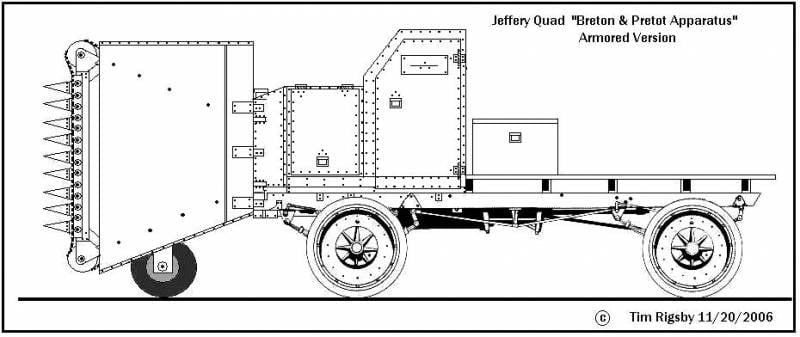
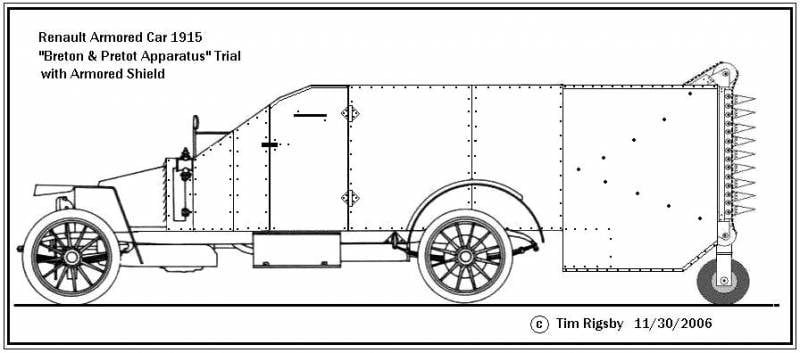
Information